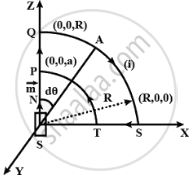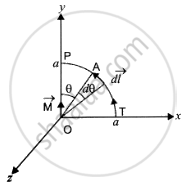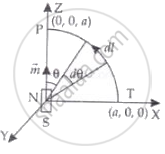Advertisements
Advertisements
Question
Verify the Ampere’s law for magnetic field of a point dipole of dipole moment m = m`hatk`. Take C as the closed curve running clockwise along (i) the z-axis from z = a > 0 to z = R; (ii) along the quarter circle of radius R and centre at the origin, in the first quadrant of x-z plane; (iii) along the x-axis from x = R to x = a, and (iv) along the quarter circle of radius a and centre at the origin in the first quadrant of x-z plane.
Solution
Consider a plane on x-z plane on which there are two loops (of radius R and a)and a point dipole on origin of dipole moment M(as shown in the figure). From P to Q, every point on the z-axis lies at the axial line of magnetic dipole of moment M.
So magnetic field induction (B) at a point (0, 0, z) from magnetic dipole (centre at origin) and having magnetic moment `vecm hatk` of magnitude `(vecm)`.
`|B| = mu_0/(4pi) (2(vecm))/z^3 = (mu_0vecm)/(2piz^3)`

(i) Ampere's law along Z axis from Z = a to Z = R i.e. from P to Q
`int_P^Q vecB.vec(dl) = int_P^Q B.dl cos θ^circ = int_P^Q B.dz`
= `int_P^Q (mu_0vecm)/(2piz^3) dz = (mu_0vecm)/(2pi) int_a^R z^(-3) dz` .....[∵ Distance of P and Q from origin are a and R respectively]
= `(mu_0vecm)/(2pi) [z^-2/(-2)]_a^R = (mu_0vecm)/(2pi(-2)) [1/R^2 - 1/a^2]`
`int_P^Q B.dl = (mu_0vecm)/(4pi) [1/a^2 - 1/R^2]`
(ii) Ampere's law along the quarter circle QS of radius R as given in figure here. Point A can be considered on the equatorial line of magnetic dipole of moment `vecm` sin θ.

Magnetic field of point A on the circular are is
`B = mu_0/(4pi) (vecm sin theta)/R^3`
`d theta = (dl)/R` ⇒ `R.d theta`
∴ By Ampere's law `int B.dl = int B.dl cos theta`
`int vecB. vec(dl) = int_0^(pi/2) mu_0/(4pi) (vecm sin theta)/R^3 * R.d theta`
`int vecB.vec(dl) = (mu_0vecm)/(4piR^2) [- cos theta]_0^(pi/2) = (mu_0vecm)/(4piR^2) [- cos 90^circ + cos theta^circ]`
`int B.dl = (mu_0vecm)/(4piR^2)`
(iii) Ampere's law along the X-axis from x = R to x = a as in given figure here.

As all point from S to T lies on equatorial line of magnetic dipole N-S. So magnetic field induction at a point P at a distance x from the dipole is
`B = mu_0/(4pi x^3) = mu_0/(4pi) (vecm hatk)/x^3`
`int vecB.vec(dl) = int_R^q (- mu_0 vecmhatk)/(4 pix^3) * vec(dl)`
∵ Angle between dl and m is 90°
So `int vecB.vec(dl) = int_R^a (- mu_0 |vecm| dl cos 90^circ)/(4pix^3)` = 0
`B = mu_0/(4pi) vecm/x^3 = mu_0/(4pi) (vecm hatk)/x^3`
`int vecB.vec(dl) = int_R^a (- mu_0 vecmhatk)/(4pix^3) * vec(dl)`
∵ Angle between dl and m is 90°
So `int vecB.vec(dl) = int_R^a (- mu_0 |vecm| dl cos 90^circ)/(4pix^3)` = 0
(iv) Ampere's law along the quarter circle of radius 'a' and centre at the origin in the quadrant X-z plane as in figure here as on part (ii).

`int B.dl = int_(pi/2)^0 mu_0/(4pi) (vecm sin theta)/a^3 * ad theta`
`int B.dl = (mu_0vecm)/(4pia^2) [- cos theta]_(pi/2)^0`
θ = angle from axial line of dipole
`int B.dl = (mu_0vecm)/(4pia) [- cos theta + cos pi/2] = (mu_0vecm)/(4pia^2) (-1 + 0) = (-mu_0vecm)/(4pia^2)`
∴ Applying Ampere's law along close path starting from P to Q, Q to S and S to P.
`oint_(PQST) B.dl = int_P^Q vecB. vec(dl) + int_Q^S vecB.vec(dl) + int_S^T vecB. vec(dl) + int_T^P B.dl`
From parts (i), (ii), (iii) and (iv) substituting the values
`oint_(PQST) B.dl = (mu_0vecm)/(4pi) (1/a^2 - 1/R^2) + (mu_0vecm)/(4piR^2) + 0 + (-mu_0vecm)/(4pia^2)`
= `(mu_0vecm)/(4pia^2) - (mu_0vecm)/(4piR^2) + (mu_0vecm)/(4piR) - (mu_0vecm)/(4pia^2)`
`oint_(PQST) B.dl` = 0
This proves that Ampere's law is magnetism.
APPEARS IN
RELATED QUESTIONS
Magnetic lines of force are closed continuous curves.
How are the magnetic field lines different from the electrostatic field lines?
Two bar magnets are placed close to each other with their opposite poles facing each other. In absence of other forces, the magnets are pulled towards each other and their kinetic energy increases. Does it contradict our earlier knowledge that magnetic forces cannot do any work and hence cannot increase kinetic energy of a system?
A bar magnet of length 1 cm and cross-sectional area 1.0 cm2 produces a magnetic field of 1.5 × 10−4 T at a point in end-on position at a distance 15 cm away from the centre. (a) Find the magnetic moment M of the magnet. (b) Find the magnetisation I of the magnet. (c) Find the magnetic field B at the centre of the magnet.
A short bar magnet placed with its axis at 30° with a uniform external magnetic field of 0.25 T experiences a torque of magnitude equal to 4.5 × 10–2 J. What is the magnitude of magnetic moment of the magnet?
A closely wound solenoid of 2000 turns and area of cross-section 1.6 × 10-4 m2 , carrying a current of 4.0 A, is suspended through its centre allowing it to turn in a horizontal plane.
What is the force and torque on the solenoid if a uniform horizontal magnetic field of 7.5 × 10-2 T is set up at an angle of 30° with the axis of the solenoid?
Magnetic field at far axial point due to solenoid as well as bar magnet varies ______.
Magnetic moment for solenoid and corresponding bar magnet is ______.
A proton has spin and magnetic moment just like an electron. Why then its effect is neglected in magnetism of materials?
A long straight wire of circular cross section of radius 'a' carries a steady current I. The current is uniformly distributed across its cross section. The ratio of magnitudes of the magnetic field at a point `a/2` above the surface of wire to that of a point `a/2` below its surface is ______.
